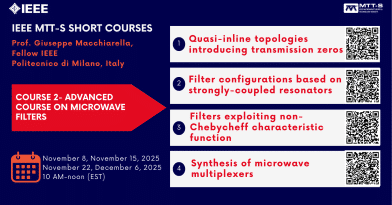
-
Saturday, November 08, 2025 10:00 am - 12:00 pmAdd to my calendar
-
Saturday, November 15, 2025 10:00 am - 12:00 pmAdd to my calendar
-
Saturday, November 22, 2025 10:00 am - 12:00 pmAdd to my calendar
-
Saturday, December 06, 2025 10:00 am - 12:00 pmAdd to my calendar
IEEE MTT-S Short Courses II: Advanced Course on Microwave Filters
Advanced course on Microwave Filters:
The evolution of communication technologies in recent years has required increasingly high performance filtering subsystems. In particular, the very strict requirements in term of selectivity, passband losses and compactness have required new and more effective synthesis solutions.
Considering the compactness and the best use of the available footprint, the inline topology represents undoubtedly a very convenient solution. Unfortunately, in its classical implementation, it suffers from scarce selectivity (no transmission zeros can be introduced in the frequency response). Although several solutions have been proposed over the years to realize quasi-inline microwave filters that have transmission zeros in the response, only recently has this goal been addressed and solved for strictly inline configurations. Another hot topic in the microwave filter world is the design of duplexers and multiplexers. Unlike filter design (today generally started by a synthesis approach), multiplexer design still makes extensive use of numerical optimization techniques right from the initial design phase. Recently, a synthesis approach for star-junction multiplexer has been proposed, allowing the derivation of an equivalent circuit of the overall structure (from which the dimensioning can be carried out with the same techniques used for filters). This approach has been improved recently, allowing the design of very high order multiplexers (over 200).
The aim of this course is to introduce the latest solutions for designing the advanced filtering configurations mentioned above. After a discussion of the general characteristics of the configurations considered, practical approaches to their design are presented, suggesting how to best use the traditional microwave CAD tools (circuit and full-wave simulators).
Speakers:
Prof. Giuseppe Macchiarella
Fellow IEEE
Politecnico di Milano, Italy
Hours: 8 (4 lessons of 2h)
Lesson1: Quasi-inline topologies introducing transmission zeros
Solutions for realizing high selectivity compact filters with simple topologies. Quasi-inline topologies topology with transmission zeros: extracted-pole; cascaded singlets; frequency dependent couplings. Synthesis based design techniques exploiting circuit and full-wave simulators; examples in various technologies (waveguide, coaxial, microstrip).
Lesson 2: Filter configurations based on strongly-coupled resonators
Concept and practical implementation. Filter configurations using strongly-coupled pair, triplet and quadruplet. Advantages and limits of filter with strongly-coupled structures. Design examples by means of the port-tuning method.
Lesson 3: Filters exploiting non-Chebycheff characteristic function
New characteristic functions that allow additional degrees of freedom in the analytical definition of the response of microwave filters. Reduced-Chebycheff and Bounded characteristic functions. Strictly inline topologies with transmission zeros: Path and Extracted-zero (advantages and limitations). Design examples and discussion on the practical dimensioning.
Lesson 4: Synthesis of microwave multiplexers
Classical approach to the design and its limitation. Synthesis-based design of star-junction duplexers: concept and practical implementation. Extension to multiplexers. Limitations of this approach and alternative solutions to overcome them. Practical design examples.
Time & Joining Link:
10 AM-noon on November 8, 2025 (Eastern Standard Time)
Register Here
10 AM-noon on November 15, 2025 (Eastern Standard Time)
Register Here
10 AM-noon on November 22, 2025 (Eastern Standard Time)
Register Here
10 AM-noon on December 6, 2025 (Eastern Standard Time)
Register Here